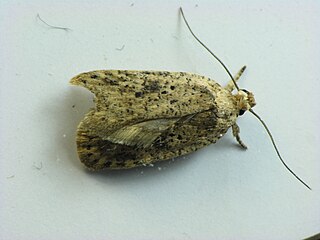
Phalonidia lavana, or Platphalonidia lavana, is a species of moth of the family Tortricidae, the subfamily Tortricinae, and the tribe Cochylini. It has a terrestrial habitat and is found throughout North America. It does not have a Global Conservation Status Rank.
Agonopterix amissella is a moth in the family Depressariidae. It was described by August Busck in 1908. It is found in North America, where it has been recorded from Florida.

Agonopterix senicionella is a moth in the family Depressariidae. It was described by August Busck in 1902. It is found in North America, where it has been recorded from Kentucky, Michigan, Ohio, Virginia and West Virginia.
Dichomeris condaliavorella is a moth in the family Gelechiidae. It was described by August Busck in 1900. It is found in North America, where it has been recorded from Florida.
Dichomeris hirculella is a moth in the family Gelechiidae. It was described by August Busck in 1909. It is found in North America, where it has been recorded from Indiana, New Hampshire and Connecticut.
Dichomeris georgiella is a moth in the family Gelechiidae. It was described by Francis Walker in 1866. It is found in North America, where it has been recorded from south-eastern Canada and Maine, south to Florida, west to Texas, Oklahoma and Illinois. It has also been recorded from Colorado and Arizona.
Dichomeris bipunctellus is a moth in the family Gelechiidae. It was described by Thomas de Grey in 1882. It is found in North America, where it has been recorded from Quebec to Maine, south to Florida and Louisiana.
Dichomeris simpliciella is a moth in the family Gelechiidae. It was described by August Busck in 1904. It is found in North America, where it has been recorded from southern Alberta to Texas, eastern Washington, south-eastern Nevada and Arizona. It has also been recorded from northern Mexico.
Dichomeris washingtoniella is a moth in the family Gelechiidae. It was described by August Busck in 1906. It is found in North America, where it has been recorded from Connecticut, southern Ontario, Kentucky, Ohio, Kansas and Oklahoma.
Dichomeris leuconotella is a moth in the family Gelechiidae. It was described by August Busck in 1904. It is found in North America, where it has been recorded from Nova Scotia to Maryland, southern Canada, Washington, Colorado, Iowa and Indiana. The habitat consists of open fields.
Dichomeris ligyra is a species of moth in the family Gelechiidae. It was described by Edward Meyrick in 1913. It is found in Gauteng, South Africa.
Dichomeris tristicta is a moth in the family Gelechiidae. It was described by August Busck in 1914. It is found in Panama.
Dichomeris varronia is a moth in the family Gelechiidae. It was described by August Busck in 1913. It is found in Panama and Guyana.
Chionodes xanthophilella is a moth in the family Gelechiidae first described by William Barnes and August Busck in 1920. It is found in North America, where it has been recorded from California, Arizona, Nevada, New Mexico, Texas and North Dakota.
Gnorimoschema florella is a moth in the family Gelechiidae. It was described by August Busck in 1903. It is found in North America, where it has been recorded from Colorado and California.
Gnorimoschema coquillettella is a moth in the family Gelechiidae. It was described by August Busck in 1902. It is found in North America, where it has been recorded from California and Colorado.
Gnorimoschema gibsoniella is a moth in the family Gelechiidae. It was described by August Busck in 1915. It is found in North America, where it has been recorded from Alberta, Manitoba and Illinois.
Gnorimoschema washingtoniella is a moth in the family Gelechiidae. It was described by August Busck in 1904. It is found in North America, where it has been recorded from Washington state.
Compsosaris flavidella is a moth in the family Gelechiidae. It was described by August Busck in 1914. It is found in Panama.
Nealyda kinzelella is a moth of the family Gelechiidae. It was described by August Busck in 1900. It is found in North America, where it has been recorded from Florida.

